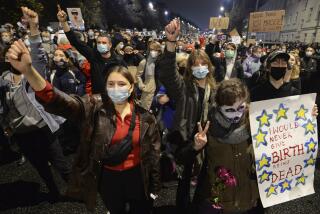‘68 Reforms Are the Hope of the Future : Czechs Lag, but Could Rescue Perestroika
- Share via
The crushing of the Prague Spring 20 years ago is the most tragic event in the history of Soviet corruption of Eastern Europe. Yet, ironically, “socialism with a human face,” which was the ambition of the Prague Spring, is the last hope for Mikhail S. Gorbachev as he surveys the ruins of a Stalinist system that appears so resistant to reform.
The Warsaw Pact forces on Aug. 21, 1968, destroyed the last truly idealistic effort to reform the Stalinist system. Whether the Czechoslovak reformers could have developed an economically viable, democratic, humane “socialist” alternative to the Stalinist system remains the major question today for Gorbachev and Soviet supporters of perestroika. For Eastern Europeans the major question about the Prague Spring is: Would it have led to a pluralistic democracy, to the loss of Communist Party monopoly, to a mixed economy and then to the withdrawal from the Warsaw Pact, in which case the Soviet invasion was inevitable?
The unfulfilled Czechoslovak reforms are, therefore, the model for perestroika and the hope for the future of Eastern Europe. Janos Kadar picked up the smashed ideas of the Prague Spring and reassembled them in Hungary over the past 20 years. The cautious pace of Hungarian reforms obviated Soviet military intervention but also largely deprived the reforms of the spirit and energy that could bring broad-based support to make them work. The reform movement in Eastern Europe is lifeless and must now draw on Moscow for new ideas, but the point of reference in Moscow, as is ever more openly discussed, is the Prague Spring.
Seemingly the last nation in Eastern Europe prepared to return today to that hopeful season in 1968 is Czechoslovakia, whose leaders still tremble before uttering the word reform . Yet there are a few hopeful signs. Some of the old reformers are still around and know what must be done. Jiri Dienstbier, one of the ’68 reformers and now a prominent dissident, told me on a visit to Prague last month, “You are too pessimistic--there is real hope.”
One hope is that the new party leader, Milos Jakes, will be so energized by Gorbachev during their vacation together this summer on the Black Sea that he will return encouraged to work with closet reformer, Premier Lubomir Strougal, to take bolder steps to change and humanize the system. The Czechs, with a highly skilled and talented population, a minimal foreign debt and the strongest tradition of democracy in Central Europe, still have a chance to help guide Gorbachev back to the future--to the Prague Spring.
The larger question is: Can, and should, the West participate in this process of change in Eastern Europe? The answer must be yes! An erupting crisis is coming to one or more nations of Eastern Europe as partial reforms prove unworkable, as old leaderships become more intransigent and as the people are led to expect more economic and political benefits. Such an eruption could sweep Gorbachev from his path and set back the dramatic improvement in East-West relations.
The Soviets must begin to promote change in Eastern Europe and not just sit back on the pretext of a new policy of “non-interference and mutual respect.” The Gorbachev leadership cannot simply wash its hands of the residue of 40 years of stagnation in Eastern Europe, since putting off reform could be more risky than stimulating gradual change. The Western nations should work together to greatly expand political, cultural and trade contacts with all the nations of Eastern Europe and to talk to the Soviets about the risks and opportunities of this new era. The United States must drop its out-of-date “policy of differentiation.”
The major task for the Soviet Union is that it must encourage systemic change in Eastern Europe to provide greater benefits to the people and economies of this traditionally anti-Russian region without stimulating revolution or greatly weakening the Soviet system of security. Soviet academics and some leaders amazingly seem now to understand this challenge in precisely those terms.
The major task for the United States and its Western allies is to promote economic well-being, peaceful change and free choice for the peoples of Eastern Europe without encouraging a hostile geopolitical environment for the Soviet Union on its western border and without undermining Soviet reforms. The difficult task for the Soviet Union and the Western alliance is to try to manage this process of change with the largely stagnant and insecure leaderships of Eastern Europe, who could be the big losers.
Can the East and West begin now to discuss alternative futures for Eastern Europe. Should we look to a gradual and balanced demilitarization of the two military blocs or, alternatively, to the gradual “Austrianization” of individual countries such as Hungary, thus reducing the size of the blocs? The most hopeful sign is that the question before East and West today for the first time in 20 years is not how to debate the tragic end of the Prague Spring but how to revive it and make it endure.
More to Read
Sign up for Essential California
The most important California stories and recommendations in your inbox every morning.
You may occasionally receive promotional content from the Los Angeles Times.













